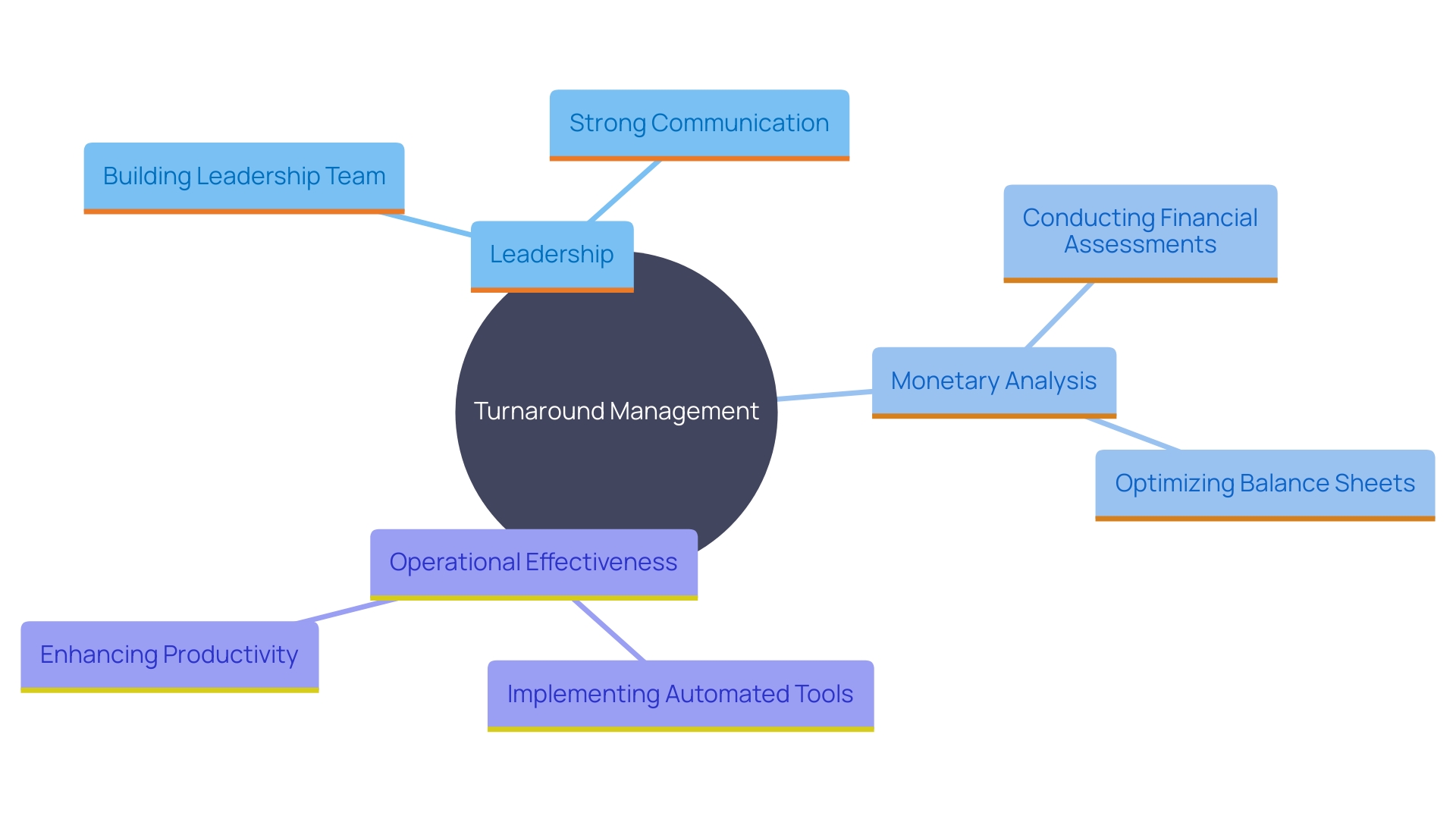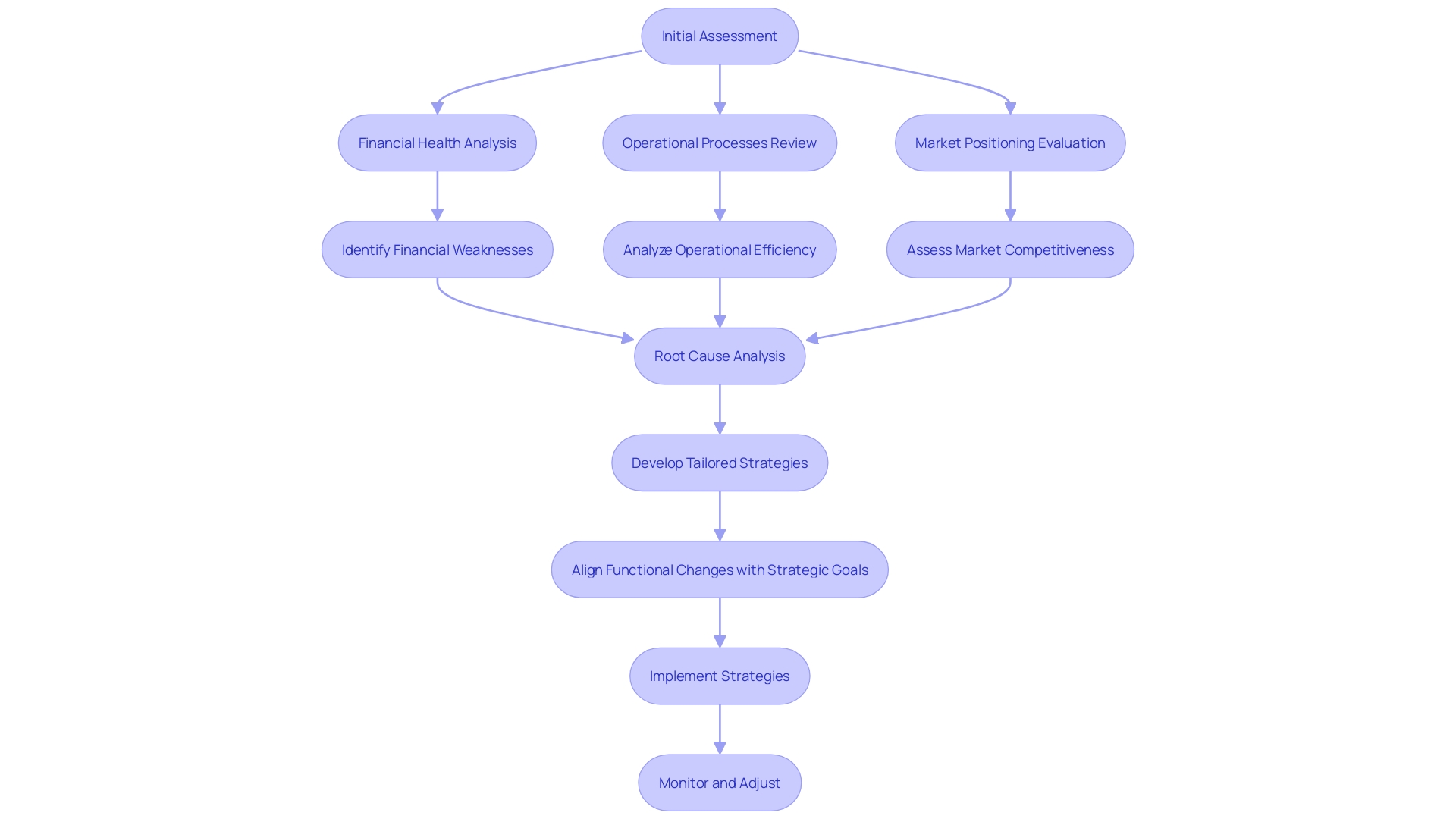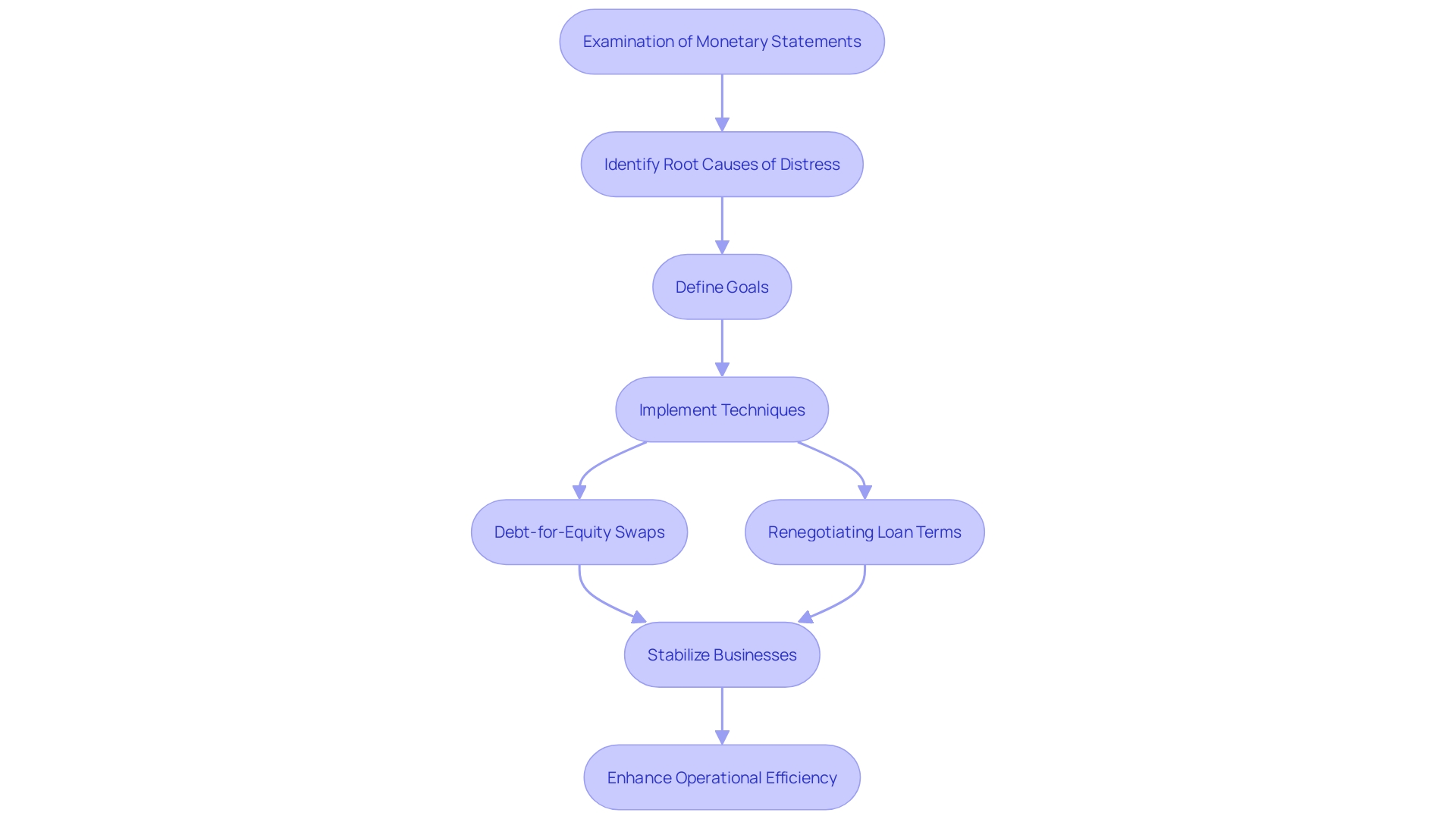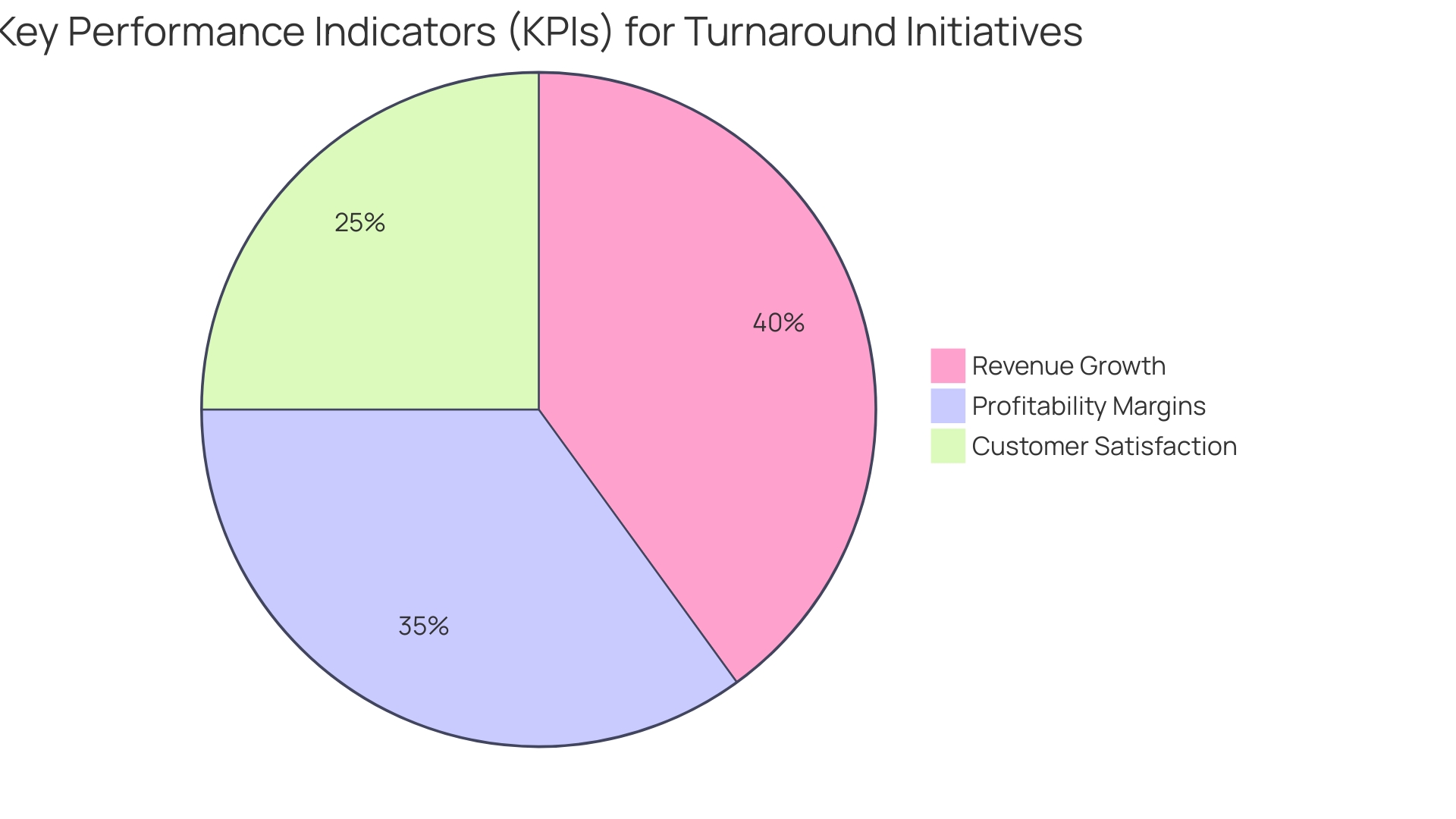Introduction
In the ever-evolving business landscape, turnaround management stands as a critical lifeline for companies facing financial distress. This article delves into the essential elements that underpin successful turnaround efforts, offering insights into leadership dynamics, financial restructuring, and operational efficiency. By examining comprehensive assessment methods and the strategic use of financial techniques, it illuminates how businesses can not only stabilize but also thrive amidst challenges.
Additionally, it underscores the importance of evaluating turnaround outcomes through robust performance metrics and post-implementation reviews. This holistic approach ensures that interventions are impactful and sustainable, empowering businesses to navigate through turbulent times with resilience and strategic foresight.
Key Elements of Turnaround Management
Turnaround management hinges on several critical elements that drive the success of restructuring efforts. Key components include strong leadership, comprehensive monetary analysis, and improved operational effectiveness. Effective turnaround firms prioritize building a leadership team capable of navigating complex business landscapes, implementing strategic changes, and inspiring staff.
Financial analysis plays a pivotal role in identifying liquidity issues, assessing debt levels, and developing realistic recovery plans. As highlighted by Dr. Jacobs from the University of Dayton, a thorough assessment of the financial situation involves reviewing all financial statements to pinpoint areas requiring immediate attention. For example, identifying underperforming products can inform decisions on whether to discontinue them or find ways to boost their sales.
Operational effectiveness concentrates on minimizing waste and enhancing productivity, ensuring optimal resource allocation. Automated tools and digital services, as noted by Andrii Holubenko, have revolutionized this aspect by automating routine tasks and freeing up valuable manpower. This enables businesses to better utilize available resources and enhance overall efficiency. In essence, the integration of new technologies not only streamlines operations but also provides opportunities for precise segmentation and targeted strategies, crucial for building a loyal customer base.

Assessment and Diagnosis in Turnaround
A comprehensive assessment and diagnosis phase is essential for any successful turnaround. This entails a thorough assessment of the organization's monetary condition, operational processes, and market positioning. Turnaround specialists deploy various analytical tools and techniques to identify root causes of decline, such as cash flow issues, market misalignment, or ineffective management practices. This diagnostic phase lays the groundwork for tailored strategies that address specific challenges, ensuring that interventions are both relevant and impactful.
For instance, examining financial health involves detailed financial analysis and cash flow monitoring. Turnaround experts utilize advanced data analytics to pinpoint inefficiencies and areas for improvement. Operational processes are scrutinized to enhance asset utilization and drive profitability. Market positioning is analyzed to ensure alignment with current market trends and customer needs.
In the case of Intuit, the company recently announced a strategic shift by laying off 1,800 employees to refocus on artificial intelligence and customer-centric roles. This move highlights the importance of aligning functional changes with long-term strategic goals, a critical component of the diagnosis phase.
Furthermore, value creation is assessed both in the short-term and long-term, relating directly to the business strategy. This involves making strategic and functional changes that enhance overall value. By employing these rigorous diagnostic methods, businesses can develop customized turnaround plans that effectively address their unique challenges and drive sustainable growth.

Financial Restructuring Techniques
Effective economic reorganization is essential for stabilizing troubled businesses and paving the way for long-term recovery. This process involves reorganizing a company’s monetary obligations to enhance stability and operational efficiency. Key techniques include renegotiating debt terms, securing new financing, and divesting non-core assets. For instance, debt-for-equity swaps can be employed to improve the balance sheet by converting debt into equity, thus reducing the debt burden and freeing up resources for investment in growth opportunities.
A thorough examination of monetary statements, including balance sheets, income statements, and cash flow statements, is the first step in this process. Recognizing the root causes of monetary distress, such as high debt levels or liquidity issues, is essential. This enables the definition of clear goals, such as reducing debt, improving cash flow, and optimizing the capital structure.
Turnaround firms utilize their knowledge to develop customized economic strategies that tackle urgent challenges and prepare the organization for future expansion. For example, a bank’s decision to reclassify private corporate bonds from “held to collect and sell” to “held to collect” reflected a strategic shift to stabilize available capital. In the same way, modifying the capital structure and renegotiating loan terms with creditors can significantly lessen economic strain.
Overall, financial restructuring aims to create a sustainable financial framework, ensuring the organization can navigate through financial distress and emerge stronger. This method not only boosts liquidity but also increases operational effectiveness, allowing organizations to concentrate on growth and profitability.

Evaluating Turnaround Outcomes
Evaluating the outcomes of turnaround initiatives is critical for assessing their effectiveness and ensuring sustainable growth. Key performance indicators (KPIs) such as revenue growth, profitability margins, and customer satisfaction metrics serve as primary measures of success. Revenue growth shows if the company is increasing its market share and producing more sales, while profitability margins disclose the effectiveness of cost management and the overall condition of the business.
Additionally, customer satisfaction metrics provide insights into the quality of service and product delivery, which are essential for long-term retention and loyalty. To further ensure the effectiveness of turnaround strategies, firms often conduct post-implementation reviews. These reviews assess whether the strategic interventions have had a lasting impact on the organization.
The importance of evaluating these initiatives is underscored by industry experts. As stated by Patti P. Phillips, PhD, Chief Executive Officer of ROI Institute, Inc., "Seeing the value of money spent on programs and projects is at the top of senior leaders' minds worldwide. This includes the impact and return on investment in major initiatives." Post-implementation reviews not only help in recognizing successful strategies but also aid in refining future efforts, making them more targeted and effective.
Moreover, case studies reveal that organizations that systematically evaluate their turnaround initiatives are better positioned to adapt to market changes and maintain financial stability. For instance, firms that leverage data analytics to monitor KPIs and conduct thorough reviews tend to achieve higher returns on investment and improved operational efficiency.
In conclusion, the systematic evaluation of turnaround initiatives, through the use of KPIs and post-implementation reviews, is indispensable for ensuring their long-lasting impact and refining future strategies.

Conclusion
Successful turnaround management relies on strong leadership, thorough financial analysis, and operational efficiency. A capable leadership team is crucial for navigating challenges and inspiring employees, while financial assessments help identify liquidity issues and shape recovery plans. Advanced technologies further enhance operational efficiency, optimizing resource use and productivity.
The assessment and diagnosis phase is vital for uncovering the root causes of decline. Turnaround specialists employ analytical tools to evaluate financial health, operational processes, and market positioning, leading to tailored strategies that effectively address specific challenges.
Financial restructuring techniques are essential for stabilizing distressed companies. Key strategies include renegotiating debt terms, securing new financing, and divesting non-core assets. By optimizing the capital structure and improving liquidity, businesses can focus on growth opportunities.
Evaluating the outcomes of turnaround initiatives is critical for measuring effectiveness. Key performance indicators such as revenue growth, profitability margins, and customer satisfaction serve as benchmarks for success. Post-implementation reviews allow firms to refine strategies and adapt to market changes.
In summary, effective turnaround management encompasses strong leadership, rigorous assessment, strategic financial restructuring, and thorough evaluation of outcomes. By embracing these principles, companies can stabilize and thrive, ensuring sustainable growth and resilience in challenging environments.




